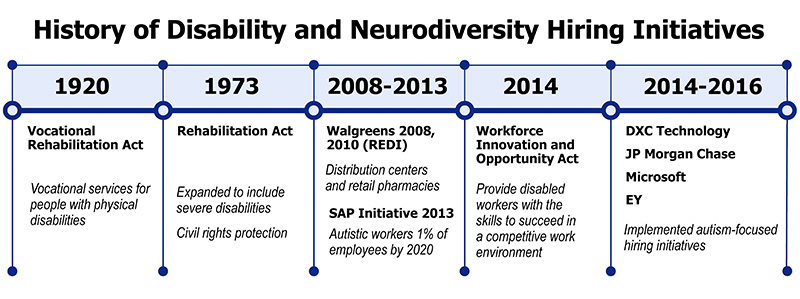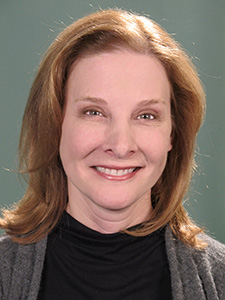Standard recruiting and interviewing processes are designed for the ways neurotypical candidates think. Unfortunately, these practices often obscure the talents neurodivergent candidates can bring to an organization. While some autistic individuals do obtain employment through an employer’s standard recruiting process without disclosing they have a neurodivergent profile or requesting an accommodation, the unemployment statistics suggest that those individuals are in the minority. To address this, some employers are modifying their recruiting and interviewing practices to provide autistic candidates the opportunity to demonstrate their skill sets in ways that suit their presentation styles, while others have gone as far as setting up completely distinct programs for hiring autistic employees.
The History of Neurodiversity Hiring Programs
Present day neurodiversity hiring programs have evolved from a combination of federal and corporate initiatives.

The Vocational Rehabilitation Act of 1920, which provided funds for people with physical disabilities, laid the groundwork for the current vocational service system for people with disabilities in the U.S. Over the years, the Vocational Rehabilitation Act was expanded to include services for persons with other types of disabilities. The Rehabilitation Act of 1973 was passed to include persons with severe disabilities and incorporate civil rights protection for persons with disabilities (Idaho Department of Vocational Rehabilitation, n.d.). In 2014, the passage of the Workforce Innovation and Opportunity Act (WIOA) updated the laws governing vocational services. Unlike prior legislation, WIOA was meant to ensure disabled workers are provided with the skills to succeed in a competitive employment environment and engage employers in a more meaningful way in the process of creating employment opportunities for people with disabilities.

Marcia Scheiner
On the corporate side, in 2008 Walgreen’s started hiring a significant number of employees with disabilities to work in two major distribution centers, and in 2010 started the Retail Employee Disability Initiative to train people with disabilities in their retail pharmacies. In March 2013, SAP announced its intention to have 1% of its workforce be comprised of autistic employees by 2020. For a Fortune 500 company, this was an incredible commitment at that time.
With SAP’s announcement, hopes rose that doors would begin opening at large employers interested in including autistic jobseekers in their ranks. SAP was followed by several other global employers in making significant commitments to implementing autism hiring programs – DXC Technology (2014), JPMorgan Chase and Microsoft (2015) and EY (2016). Today, these five employers have the largest neurodiversity hiring efforts, measured by number of employees hired, among multi-national corporations. Additionally, at least fifty other major corporations, worldwide, have launched hiring initiatives targeting neurodivergent talent.
Hiring Approaches
The approaches employers take to include autistic individuals can range from hiring initiatives developed solely for neurodivergent candidates to creating inclusive processes within the company’s existing hiring practices.
Distinct Hiring Processes – Some companies choose to establish an autism hiring program that is distinct and separate from their regular recruiting and interviewing practices. These programs include screening processes developed specifically for autistic individuals that require candidates to spend anywhere from one to several weeks in hands-on activities and team exercises at the company, to judge their technical and work readiness skills, before determining which candidates will receive an offer of permanent employment. Individuals who do receive an offer may be hired as part of a dedicated team of specialists, working under one manager, on a specific task (i.e. data analysis or software testing), or they may be assigned to jobs within the organization. These multi-week screening programs can be run by the employer or by third party organizations hired to assist with the process.
Integrated Hiring Processes – Other companies choose to integrate their autism hiring efforts into their existing recruiting and interviewing practices. This entails detailed reviews of current recruiting and interviewing practices to make modifications appropriate for autistic candidates. Some of the key areas of focus in such a review include:
- Reviewing current diversity and inclusion practices related to people with disabilities
- Determining appropriate open roles available for autistic candidates
- Writing “autism-friendly” job descriptions
- Reviewing the interview process, including review of questions, inclusion of skills-based testing and determination of appropriate interview formats (e.g., individual interviews, panel interviews, etc.)
- Determining training needed for recruiters, hiring managers and other staff to ensure they know how to create an appropriate interview experience for autistic candidates
Autistic individuals hired through this approach go through an employer’s typical recruiting and interviewing process, allowing for customized modifications based on each candidate’s needs, with the goal of obtaining an inclusive role in the organization.
Regardless of which model an employer chooses, the hiring of the candidate is just the beginning. All successful models include structured ongoing support for both the autistic employees and their managers.
Specialized Companies – In addition to large corporations seeing the value in hiring autistic talent, a number of companies, founded specifically to hire predominantly neurodivergent professionals, have been founded by autistic individuals, allies of those on the spectrum and business entrepreneurs. Many of these companies, such as Ultranauts, Daivergent, Iterators, Autonomy Works, Aspiritech and Auticon focus on technology related jobs.
Where Do You Find Autistic Talent?
With the growth of neurodiversity hiring programs, the frustrating reality for the autism community is that the under- and unemployment rate for autistic individuals has not seen any noticeable improvement. Even companies with the most developed autism hiring programs claim they struggle at times to find autistic talent to fill open roles. This challenge is driven by two factors. One, many of the opportunities being identified for autistic candidates today are in technology. While 35% of eighteen-year-olds with an autism spectrum diagnosis attend college (Shattuck et al., 2012), not all of them are interested in or qualified for technology-related roles. As a result, this creates a relatively small talent pool for technology jobs. Employers who think more broadly about the roles available for autistic employees will find a broader candidate pool.
Two, in seeking autistic candidates, many employers look to the traditional source for employees with disabilities: local vocational services agencies. Not everyone with autism, particularly college graduates, registers with their state vocational agency, as these organizations are not always effective in finding competitive employment for autistic candidates with college or advanced degrees. Employers also report mixed experience with vocational rehabilitation (VR) agencies. A 2018 study completed by the United States Government Accountability Office found that “(e)mployers in one of four discussion groups said that VR does not always provide enough qualified job candidates to meet their needs, and employers in another discussion group said that job candidates referred by VR are not always good matches for their hiring needs.” (GAO Publication No. GAO-18-577, p. 14)
Conclusion
Standard recruiting and interviewing practices are a barrier to entry to the workforce for most autistic jobseekers. In 2013, SAP led the way in trying to combat this problem by establishing the first Autism@Work program targeted at hiring professional level autistic individuals. Since then, over 50 other U.S. corporations have launched or announced plans for similar programs. While these programs are still in their infancy in terms of tackling the level of under- and unemployment in the autism community, they can provide a viable option for autistic talent. Since not every company implements the same model when establishing an autism hiring initiative, it is important to evaluate the available models to determine which will be the best fit for your needs.
Marcia Scheiner is President of Integrate Autism Employment Advisors. This article is adapted from the author’s upcoming book “The Neurodivergent Job Candidate: Recruiting Autistic Professionals” due out later this year. For additional information, please contact the author at marcia@integrateadvisors.org or visit Integrate’s website at www.integrateadvisors.org.
References
Idaho Department of Vocational Rehabilitation. (n.d.) About VR. Retrieved September 1, 2020, from https://vr.idaho.gov/about/
Shattuck, P. T., Narendorf, S.C., Cooper, B., Sterzing, P. R., Wagner, M., & Taylor, J L. (2012). Postsecondary education and employment among youth with an autism spectrum disorder. Pediatrics, 129(6). https://doi.org/10.1542/peds.2011-2864
United States Government Accountability Office. (2018). Vocational rehabilitation: Additional federal information could help states serve employers and find jobs for people with disabilities. (GAO Publication No. GAO-18-577). https://www.gao.gov/assets/700/694369.pdf






Far From Home – the adventures of an adult with high functioning autism.
These are great ideas, location is an issue I believe. My son is highly functional, completed a master’s degree in Environmental Science, and is working at Safeway, 3 years and counting, bagging groceries and getting carts. His theses involved GIS mapping of environmentally sensitive area of Papua New Guinea. Every door he takes he is greeted with a big smile, the handshake, and the inevitable I’m sorry. It’s been 5 years since he graduated (2016) and now time is also becoming a factor in the sorry, we wish you luck scenario, so he has more or less quit actively looking. I don’t know what to do. I’m aging, and he is getting older (32) and doesn’t want to move to other states. We live in Chico, CA. We have a good home here, and a move to high rent would not be a practical solution. Sacramento would be acceptable, as would Redding, CA. Chico would be ideal. WE NEED HELP. Any ideas would be appreciated.
Beverly Stambaugh
bstamb@comcast.net
Hi Beverly – feel free to contact the author at marcia@integrateadvisors.org.
Hello Marcia: My son (Colin) is a 25 year old student at RIT, which has a great Spectrum Support Program. Colin is studying Electro-Mechanical Engineering. He needs 12 months of internships in order to graduate. He has applied for over 60 internships but without success. He has a 3.0 grade point average but has been taking a reduced course load for 4 years; he is now 80% of the credits he needs to graduate. Are you aware of any organizations that might help him with the job search or do you have a list of companies he should contact? Thanks for you help.
Mike O’Donnell
240-678-4237